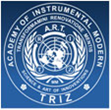THE PILLARS OF TRIZ

TRIZ – Theory of Inventive Problem Solving – was founded in Russia by the inventor, writer and independent scientist Genrikh Saulowitsch Altshuller.
The first steps¹ towards development of what would later become TRIZ were made by him together with Raphail Borisovich Shapiro.
The notion of "inventive problem" in TRIZ was defined as a problem whose efficient (acceptable) solution still awaits to be created because obvious solutions would be unsatisfying or they do not exist and would be impossible to obtain by using existing professional methods.


One of the most fundamental concepts introduced by TRIZ is that new inventive problems can be solved on the basis of experiences accumulated in the course of making earlier inventions in various other areas!
G. Altshuller investigated thousands of real inventions and developed the following principles governing resolution of inventive problems:


1. Identification and elimination of the systemic contradiction is the key to resolving the problem!
2. "There is an endless multitude of inventive problems, while the number of systemic contradiction types is relatively small. There are typical systemic contradictions – and typical techniques used for their elimination²." Problem resolution methods (techniques) can be identified by analyzing great inventions.
3. The strategy and tactics of directed problem resolution must rely on laws governing evolution of technical systems.
TRIZ rests on the systemic foundation of the following basic provision:

And here is yet another provision which is critically important for understanding TRIZ fundamentals:
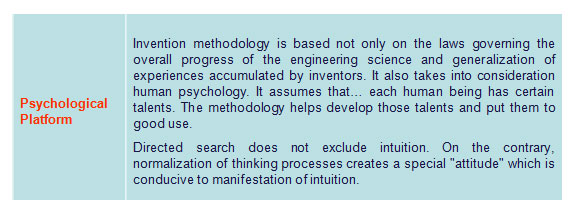
Structure of TRIZ is shown in following diagram below:
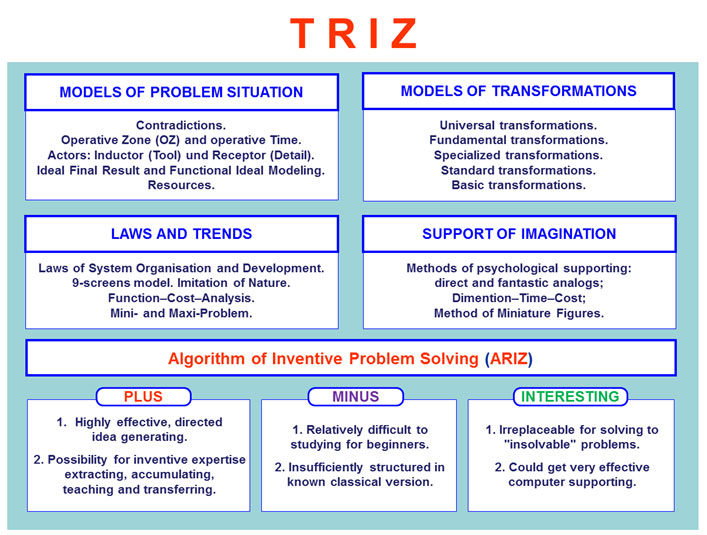
¹ The Psychology of Inventive Creativity. – Journal "Questions of Psychology", No. 6, Moscow, 1956; coauthors: Genrikh Saulowitsch Altshuller (1926-1998) and Rafail Borisovich Shapiro (1926-1993)
² Altshuller, G.S. (1961) How to Learn to Invent. – Tambov Book Publishers (in Russian)
³ Altshuller, G.S. (1986) To Find an Idea. Introduction to Theory of Inventive Problem Solving. – Novosibirsk, Nauka Publishers (in Russian; there are also later editions)
Compiled by the author (M.O.) based on: Altshuller G.S. (1961) How to Learn to Invent. – Tambov Book Publishers (in Russian)
Altshuller, G. S. (1973) Algorithm of Invention. – Moscow Worker Publishers (in Russian)
In their first article entitled The Psychology of Inventive Creativity, G. Altshuller and R. Shapiro formulated three fundamental premises which are found in each creative solution of each new problem:

1. Formulation of the problem and determination of the contradiction which prevents resolution of the problem by applying the usual methods already familiar to engineers.
2. Elimination of the cause of the contradiction with a view to attain a new – higher – technical effect.
3. Transforming the other system components to bring them into conformity with the modified component.
Resolution of problem-based contradictions requires application of special creative models and methods to constructively reorganize available professional knowledge and/or acquire new knowledge with a view to synthesize an efficient idea.
There are three fundamental types of contradiction:

Examples of general contradictions:
Ex. 01. How can you quickly detect and extinguish any fire – in a forest, in the steppe, in a building, on the ship?
Ex. 02. How can you protect from the scorching sun hundreds of acres of forest, agricultural fields, or open water surfaces?
Ex. 03. How can you prevent a catastrophe of plane, even if the engine failed?
Ex. 04. How can you prevent the formation and propagation of a hurricane?
Ex. 05. How can you ensure the elimination of traffic jams on the highways and in the cities?
Ex. 06. How can we free the world from criminal violence and drug use?
Ex. 07. How can you do lifeless mountains and desert green and blooming?
Why these sentences are General Contradictions? Please give the answer yourself.
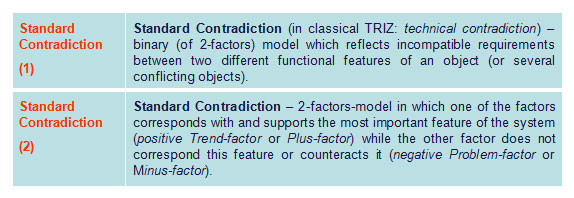



Based on a study of thousands of real inventions, several classes of transformation models has been open:
Knowing these models and the availability of skills to operate with these models make a problem solving process more productive.
Recognition of new models and the use of well-known ones can be considered in the examples.
Ex. 08 (solution of standard contradiction). That’s a Lotta Line!
Recognition and use of standardized transformations could be considered in completion of Ex. 8.
To solve this problem, we can use a very visual, graphical representation of the standard contradiction. Accordingly, selection of formal plus- and minus-factors becomes simpler (which unfortunately is not always the case in real life!)
Let us record the model in the form of a relatively more complex graphic scheme:

To solve this contradiction, special TRIZ-tools could be taken in account to get a recommendation which specialized model should be very effective for this situation! And it should be a model 18 Mediator: a) use another object to transfer or transmit an action; b) temporarily connect an object with another (easily separable) object.
Idea for the solution: attach to the thick line a long light rope which can be easily – and accurately – thrown a long distance, use such rope to pull the end of the line to the berth, and then detach the mediator rope for repeated use! Please look a table and picture!

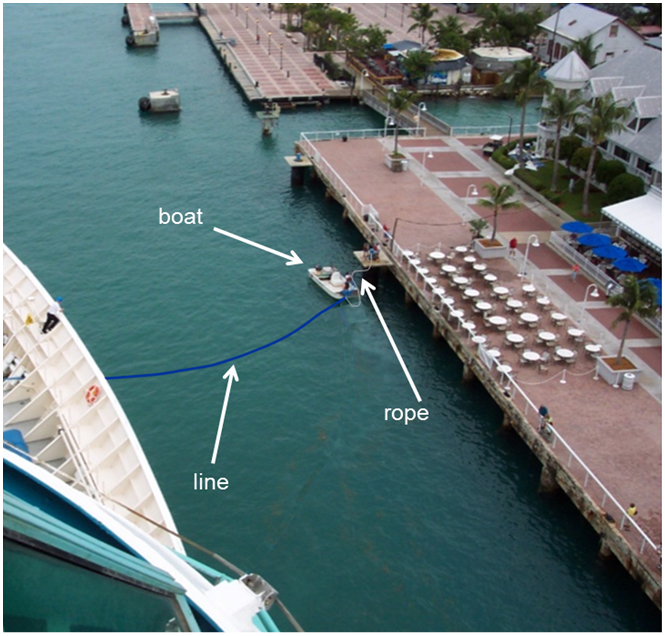
Resolution of radical contradictions is more complex than resolution of standard contradictions. There are several reasons for that. We shall note three such reasons.
First, the need to realize diametrically opposed properties in and of itself stresses out any beginner.
Second, the very transition to the radical contradiction signals that relatively simpler avenues, such as solutions based on standard contradictions, may have been exhausted.
Third, possibilities of effecting direct changes to certain resources are likely to have been used up (such resources are referred to as scarce), meaning that the required change may have to be quite drastic – and it may affect other resources.
In reality, a complexity of problems with radical contradictions often does not exceed that of problems routinely solved with the use of such instruments as specialized transformations.
But all together the models to solve the radical contradictions could be classified in 8 groups as system, informational, functional, structural, space, time, material and energy transformations.
Ex. 09 (solution of radical contradiction). How can a car fly, or an airplane drive?
According to separation of conflicting requirements in time we can see that first requirement "to be wide" should be actual at flight only and second requirement "to be narrow" should be actual during the driving along the road only! Perhaps it is not a conflict if the conflicting properties can be spread to different time intervals!
OK! But what construction could satisfy this idea?
Let us follow the known solution and extract the TRIZ-models from it!
This is a very interesting solution of company Terrafugia Inc., Massachusetts, USA. Here we can "anatomize" their inventions from TRIZ point of view.
First of all we can reformulate the initial radical contradiction into so called Bartini-state as a "unity" of two “conflicting“ requirements:
Flying car should be ►
wide (to fly with wings) AND narrow (to drive along the road)
The result is shown in three pictures:



To solve this radical contradiction, other key fundamental TRIZ-tool has been also used here: transformation in structure: dividing the wings into movable parts to supply the features 1) to fold them into a compact frame within the space of car body, and 2) to unfold them into supporting surfaces for flight. This change is in accordance with specialized TRIZ-model 03 Segmentation.
We have to note the special role of specialized model 07 Dynamization as well:
We would like also to attract your attention and to demonstrate you the special use of model 34 Matryoshka for hiding the propellers’ nacelles into the special cavities on the sides of the car for driving (look in upper picture).
We friendly recommend you to visit website www.terrafugia.com and also http://www.gizmag.com/terrafugia-public-flight-demonstration/28701/.
The aim of TRIZ is to create efficient models for inventing efficient ideas. Solving problems with embedded contradictions requires special supra-professional creative knowledge and skills which to date have been presented in an integrated form, i.e. as a certain unity of concepts, theoretical models and practice-oriented technologies, only in TRIZ.
No system (product, technology, organization, conflict situation) can develop without resolving contradictions. That is why problems defined in terms of developmental contradictions always represent a challenge for creatively-minded engineers and managers, and require full mobilization of their knowledge and creative abilities, special psychological concentration.
Application of TRIZ can be illustrated as follows.
The original problem situation arises because the prototype artifact requires an improvement, but an attempt to make such improvement creates a certain contradiction. Contradiction is a shorthand description of the problem situation model. One could also say that description of the problem is formally reduced to a contradiction.
Once that is done, it is necessary to determine the purpose – the Ideal Final Result (IFR), and formulate one or several Functional Ideal Models (FIMs) setting the direction towards the IFR (the "meta-trend").
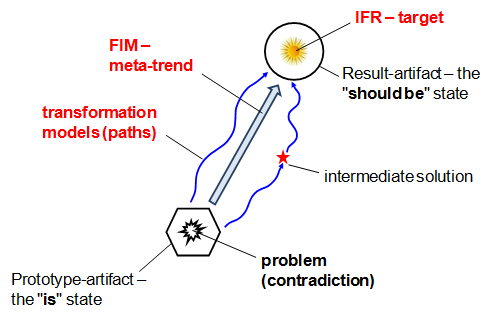
Then we need to select transformation models – specific pathways that will take us to our destination. For the various formulations of the contradiction described above, TRIZ offers the following transformation models: dynamization, matryoshka, segmentation, mediator, and some others.
Last but not least, we walk one or several of these paths – invent specific solutions and modify resources of the prototype-artifact so as to finally arrive to a new result-artifact consistent with the sought IFR as the best but maybe unachievable still target. At this way towards the IFR and through the meta-trend we need to make use of our imagination, associative thinking, experience, knowledge, character. In this case, if we follow the "prompts" provided by TRIZ in the form of transformation models as thinking navigators, emergence of an idea seems quite logical and predictable!
And, naturally, in the end of the solution generation process, we need to verify the idea, check it for implementability and efficiency.
Practical realization of such transformations of the original system is supported by ARIZ.
ARIZ – Algorithm of Inventive Problem Solving – is a method which contains practical instructions for the transformation from a state of "is" to the state of "should be" whose form and character are algorithmic.
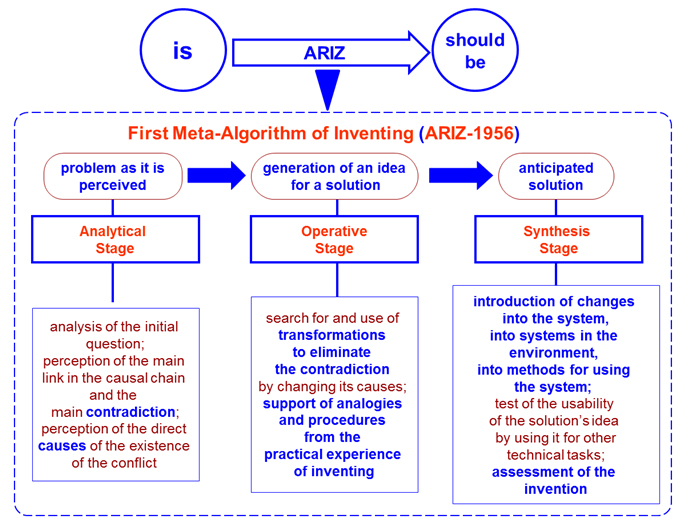
The first ARIZ was published in 1956. Genrikh Altschuller and Rafail Shapiro published a 3-phase scheme, the first "algorithm of invention" ARIZ–1956, which became not only the foundation of contradiction and transformation models but also the core of growth for the future TRIZ.
The most prominent difference of this meta-navigator of thinking to other similar schemes and theories consisted of its instrumentality and constructiveness.
Instrumentality means that three main phases of ARIZ-1956, the analytical, the operative and the synthetic, were already then equipped with the first models and recommendations for practical changes (transformation) of any object which at the same time allowed the constructiveness (goal-oriented and resultant) for ARIZ-1956.
TRIZ developed from ARIZ-1956 towards a strong key idea – towards installation and comparison of certain kinds of contradictions (of certain kinds of conflicts) corresponding a certain group of adequate and effective models of transformation. This idea wasn’t formulated in the ARIZ-1956 but soon appeared to be a natural and logical discovery that gives the models of TRIZ a constitutional similarity to models from physics, mathematics and all sciences in general.
Over the years ARIZ changed and it became more complicated, then by 1985 it developed into one of the most complicated versions and contained a double digit number of steps and transitional recommendations.

To study ARIZ-1985 is practically impossible for beginners as it is necessary to first of all master the instrumental (fundamental) models of TRIZ.
Genrikh Altshuller also stated that ARIZ is designed for a mastership level.
For a mass application we need more simple versions of ARIZ – specialized for example according to the level of education of students and users or even according to the specialized language of the specific occupation and its application.
That is why the experiences of the TRIZ education have so far proven that learning the fundamental TRIZ models on the basis of simple schemes, such as the Meta-Algorithm of Invention T-R-I-Z and others which have been elaborated in Modern TRIZ to be a necessity.
AiMTRIZ is doing research to develop new principles of organization of the tool palette, as well as teaching methods and application (M)TRIZ.
This path requires a lot of time, involvement of hundreds of partners and considerable investments.
However, we do not stop working and clearly see its prospects and future results.
